OAuth/OpenID Single Sign On (SSO) into Jira using ADFS
You can refer the steps to configure ADFS method with the Jira OAuth Client
from the video or documentation given below
Jira OAuth/OpenID app gives the ability to enable OAuth/OpenID Single Sign On for Jira Software and Jira Service Desk. Jira Software and Jira Service Desk are compatible with all OAuth/OpenID Providers. Here we will go through a guide to configure SSO between Jira and your OAuth/OpenID Provider. By the end of this guide, users from your OAuth/OpenID Provider should be able to login and register to Jira Software and Service Desk.
Pre-requisites
To integrate your OAuth/OpenID Provider with Jira, you need the following items:
- Jira should be installed and configured.
- Jira Server is https enabled (optional).
- Admin credentials are set up in Jira.
- Valid Jira Server and Data center Licence.
Download And Installation
- Log into your Jira instance as an admin.
- Navigate to the settings menu and Click Manage Apps.
- Click Find new apps or Find new add-ons from the left-hand side of the page.
- Locate Jira OAuth/OpenID Connect Single Sign On (SSO), Jira SSO via search.
- Click Try free to begin a new trial or Buy now to purchase a license for OAuth/OpenID Connect (OIDC) for Jira SSO.
- Enter your information and click Generate license when redirected to MyAtlassian.
- Click Apply license.
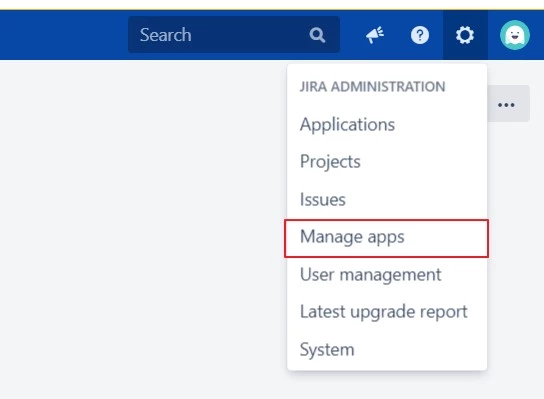
Step 1: Setup ADFS as OAuth Provider
- To perform SSO with ADFS as Provider, your application must be https enabled.
- Navigate to Server Manager Dashboard->Tools->ADFS Management.
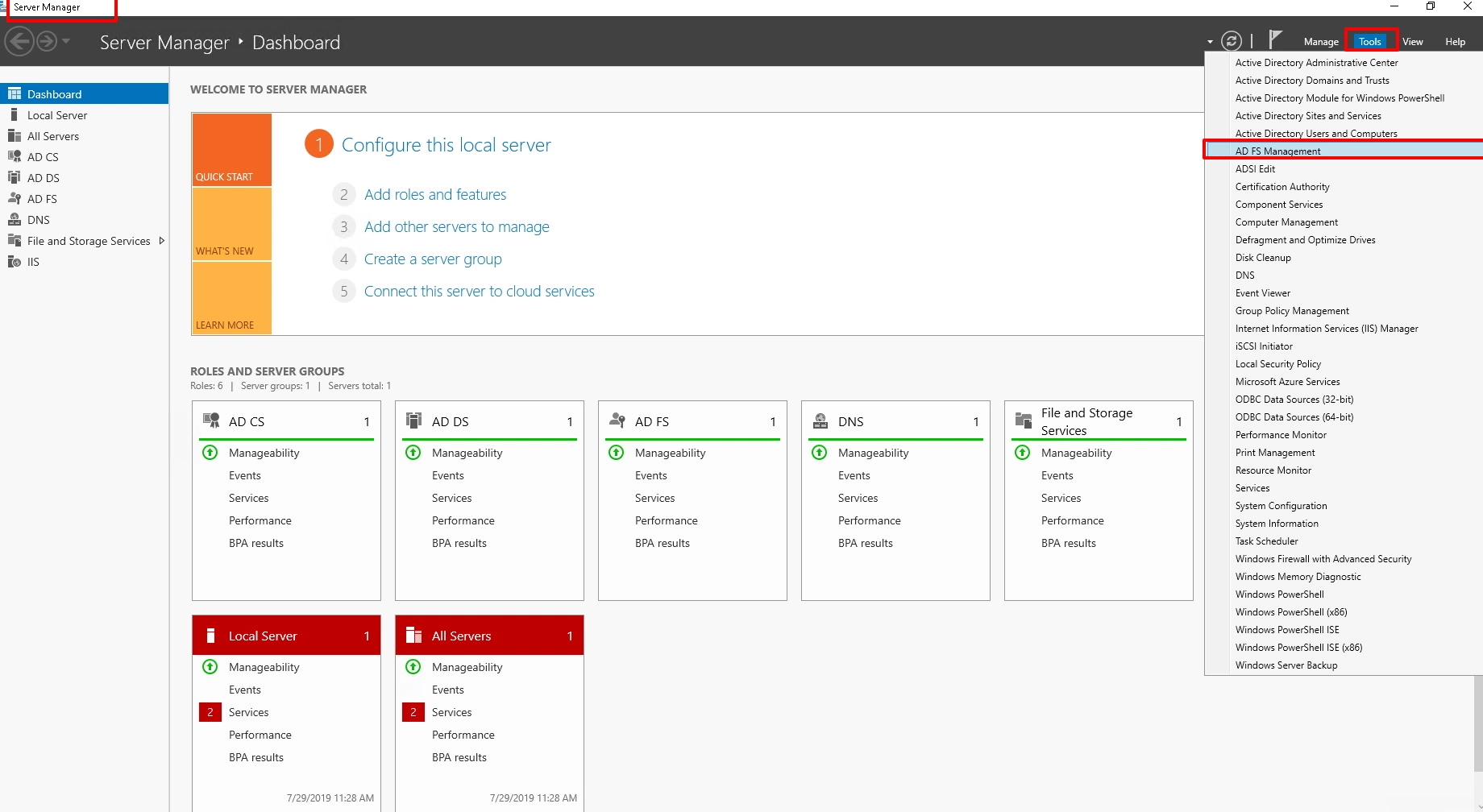
- Navigate to ADFS->Application Groups. Right click on Application Groups & click on Add Application group then enter Application Name. Select Server Application & click on next.
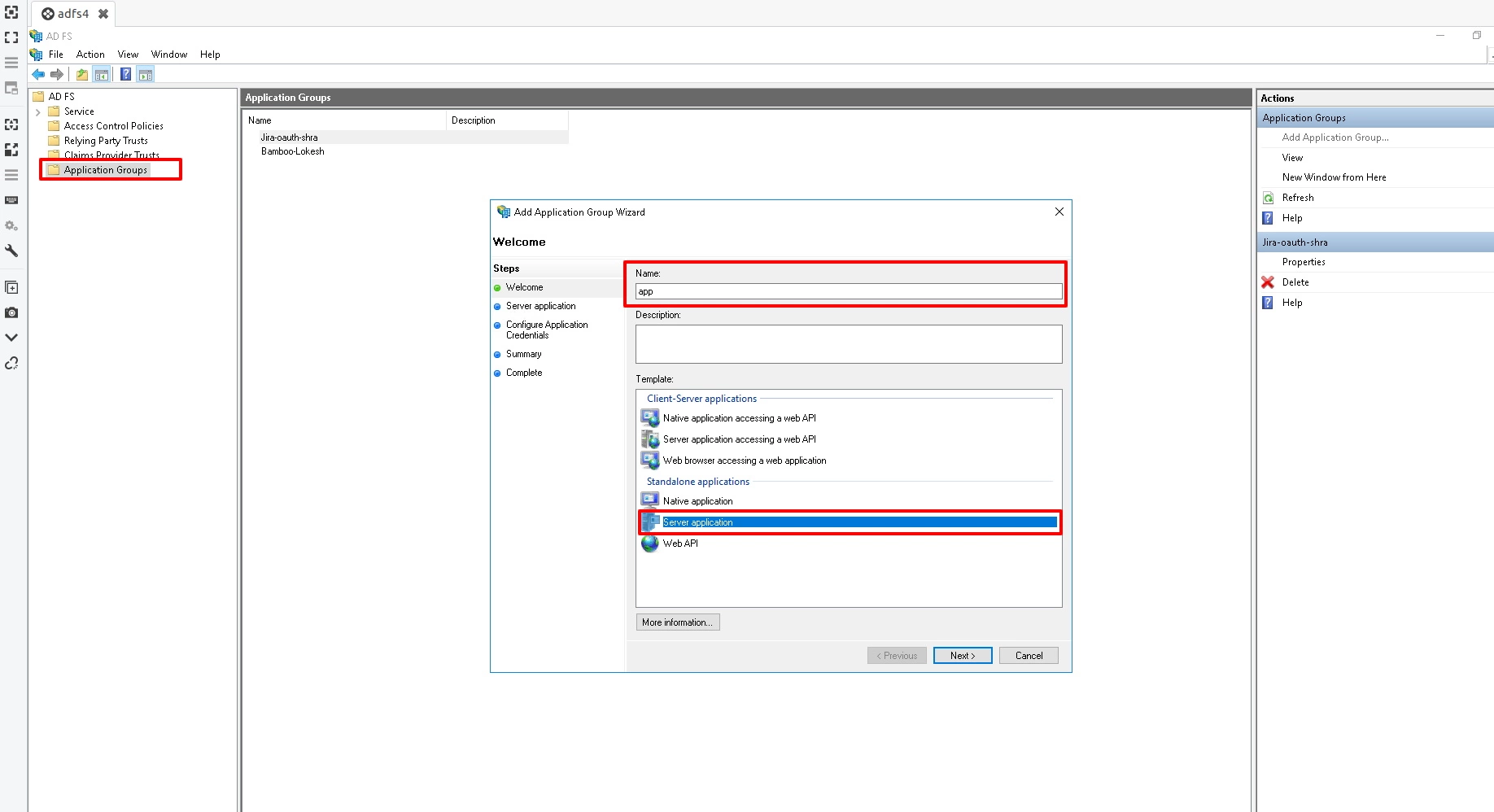
- Copy Client Identifier. This is your Client ID. Add Callback URL in Redirect URL. You can get this callback URL from plugin. Click on next.
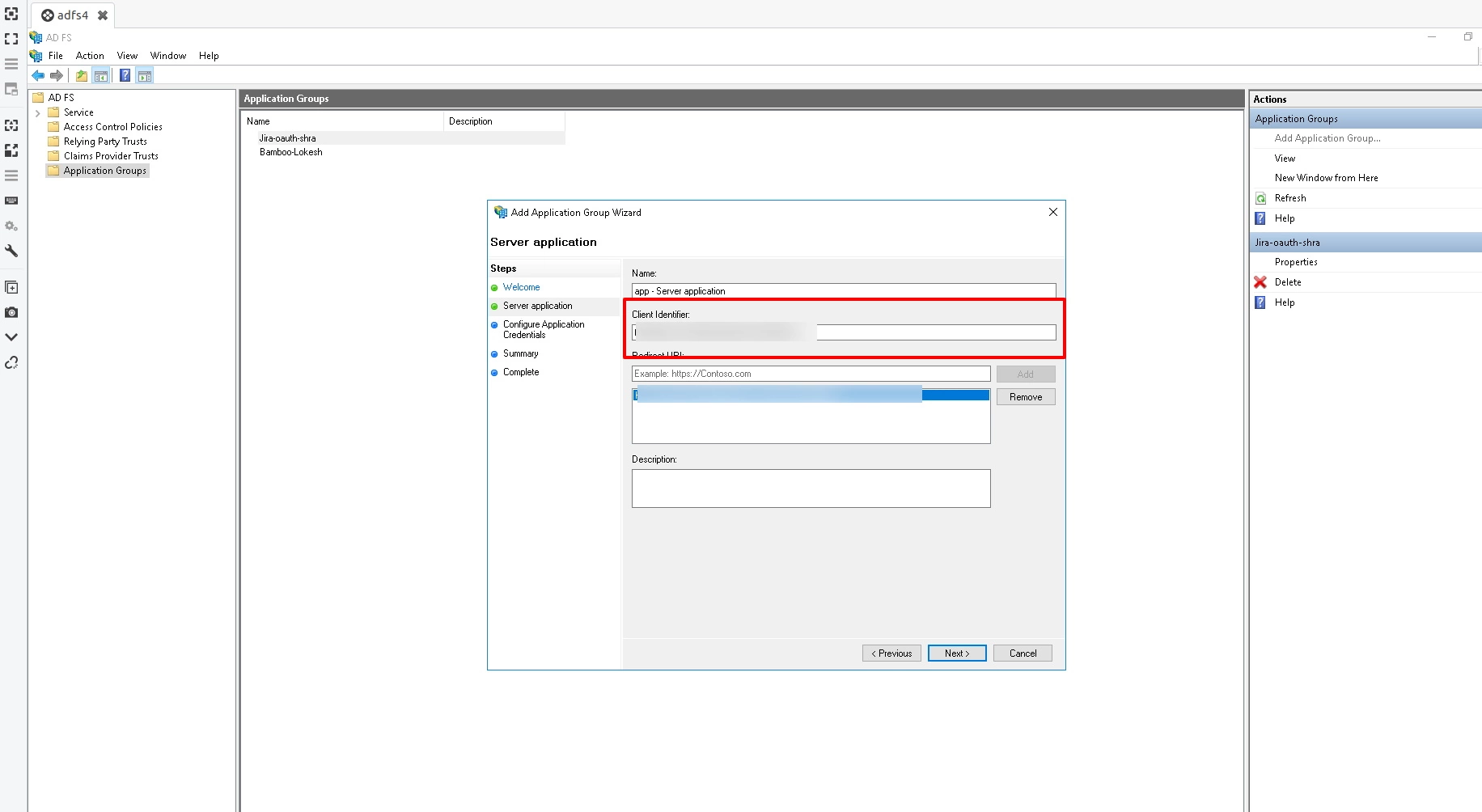
- Click on Generate shared secret. Copy the Secret value. This is your Client Secret. Click on Next.
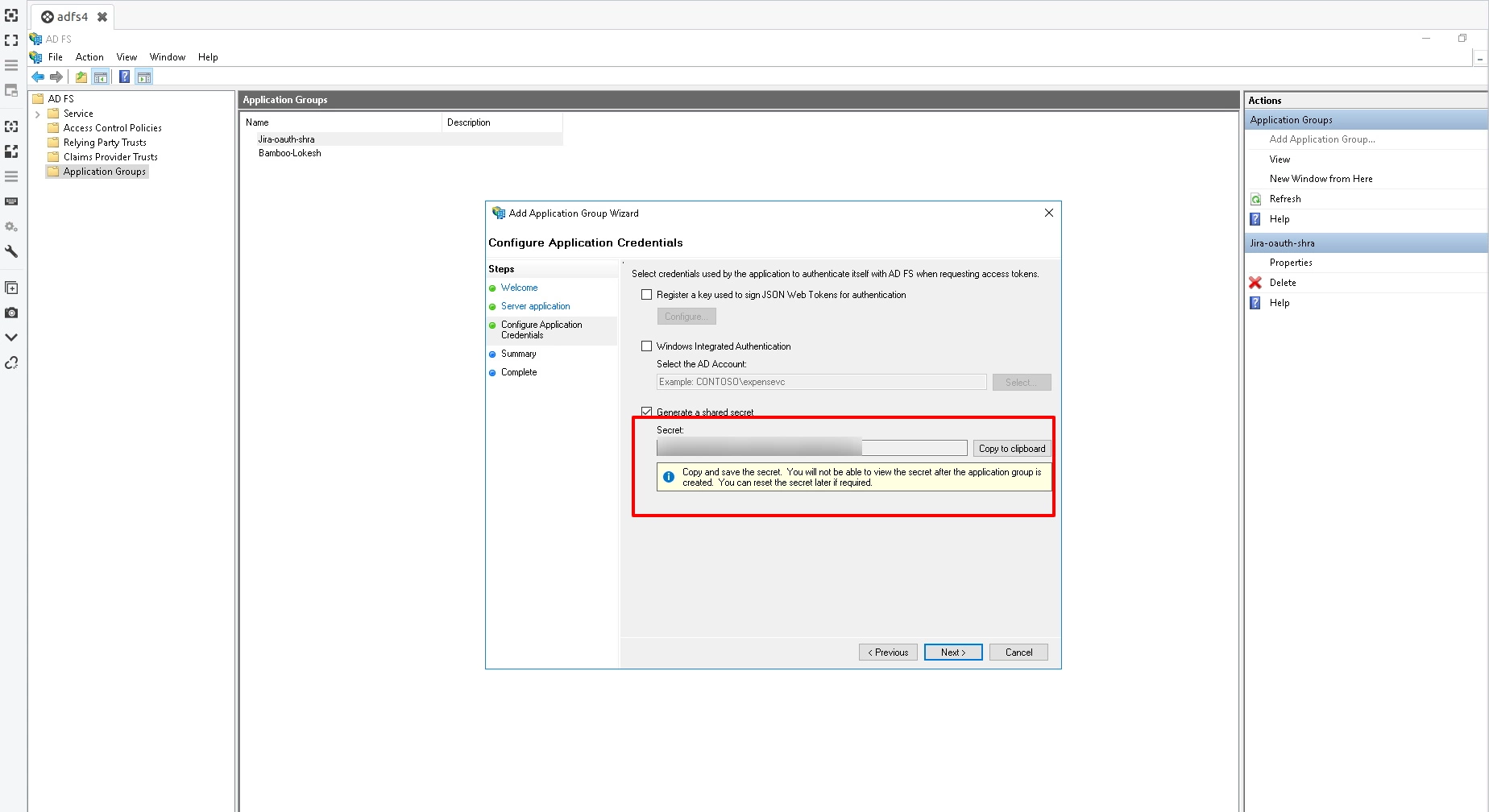
- On the Summary screen, click Next. On the Complete screen, click Close.
- Now, right-click on the newly added Application Group and select Properties.
- Click on Add application from App Properties.
- Click on the Add application. Then select Web API and click Next.
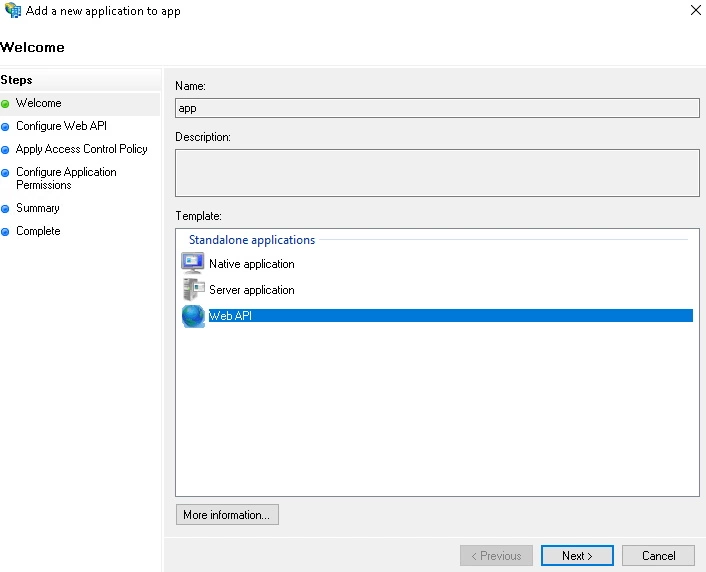
- On the Configure Web API screen, enter the domain name address into the Identifier section. Click Add. Click Next.
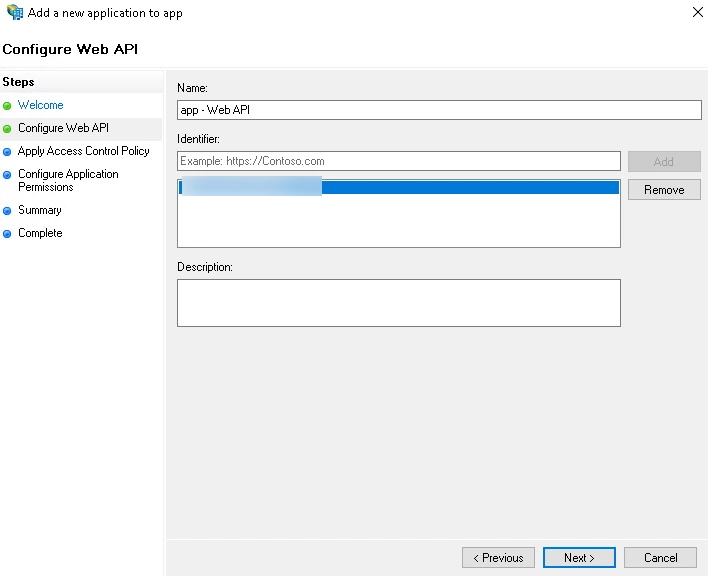
- On the Choose Access Control Policy screen, select Permit everyone and click Next.
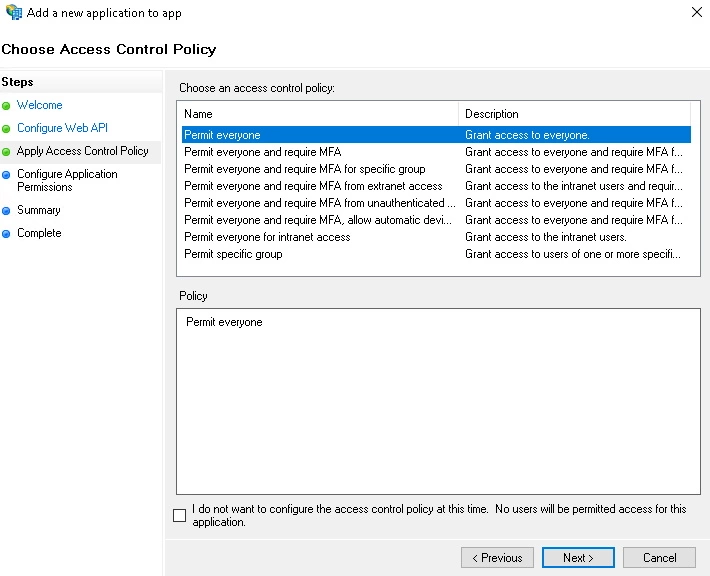
- On the Configure Application Permission, by default openid is selected as a scope & click on next.
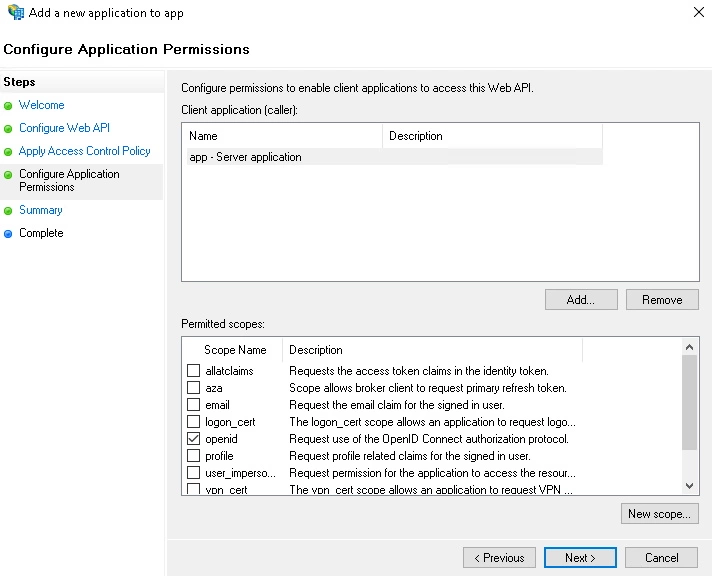
- On the Summary screen, click Next. On the Complete screen, click Close.
- On the Sample Application Properties click OK.
×
![centrify_3]()
Jira OAuth/OpenID app gives the ability to enable OAuth/OpenID Single Sign On for Jira Software and Jira Service Desk. Jira Software and Jira Service Desk are compatible with all OAuth/OpenID Providers. Here we will go through a guide to configure SSO between Jira and your OAuth/OpenID Provider. By the end of this guide, users from your OAuth/OpenID Provider should be able to login and register to Jira Software and Service Desk.
Pre-requisites
To integrate your OAuth/OpenID Provider with Jira, you need the following items:
- Jira should be installed and configured.
- Jira Server is https enabled (optional).
- Admin credentials are set up in Jira.
- Valid Jira Server and Data center Licence.
Download And Installation
- Log into your Jira instance as an admin.
- Navigate to the settings menu and Click Manage Apps.
- Click Find new apps or Find new add-ons from the left-hand side of the page.
- Locate Jira OAuth/OpenID Connect Single Sign On (SSO), Jira SSO via search.
- Click Try free to begin a new trial or Buy now to purchase a license for OAuth/OpenID Connect (OIDC) for Jira SSO.
- Enter your information and click Generate license when redirected to MyAtlassian.
- Click Apply license.

Step 1: Setup ADFS as OAuth Provider
- To perform SSO with ADFS as Provider, your application must be https enabled.
- Navigate to Server Manager Dashboard->Tools->ADFS Management.
- Navigate to ADFS->Application Groups. Right click on Application Groups & click on Add Application group then enter Application Name. Select Server Application & click on next.
- Copy Client Identifier. This is your Client ID. Add Callback URL in Redirect URL. You can get this callback URL from plugin. Click on next.
- Click on Generate shared secret. Copy the Secret value. This is your Client Secret. Click on Next.
- On the Summary screen, click Next. On the Complete screen, click Close.
- Now, right-click on the newly added Application Group and select Properties.
- Click on Add application from App Properties.
- Click on the Add application. Then select Web API and click Next.
- On the Configure Web API screen, enter the domain name address into the Identifier section. Click Add. Click Next.
- On the Choose Access Control Policy screen, select Permit everyone and click Next.
- On the Configure Application Permission, by default openid is selected as a scope & click on next.
- On the Summary screen, click Next. On the Complete screen, click Close.
- On the Sample Application Properties click OK.








×
![centrify_3]()
Step 2: Setup JIRA as OAuth Client
- Enter Client Id, client secret & ADFS domain, and scope as openid.
- Enter JWKS EndPoint URL or Public Key for signature validation.
- Click on Test Configuration for verifying the entered details.
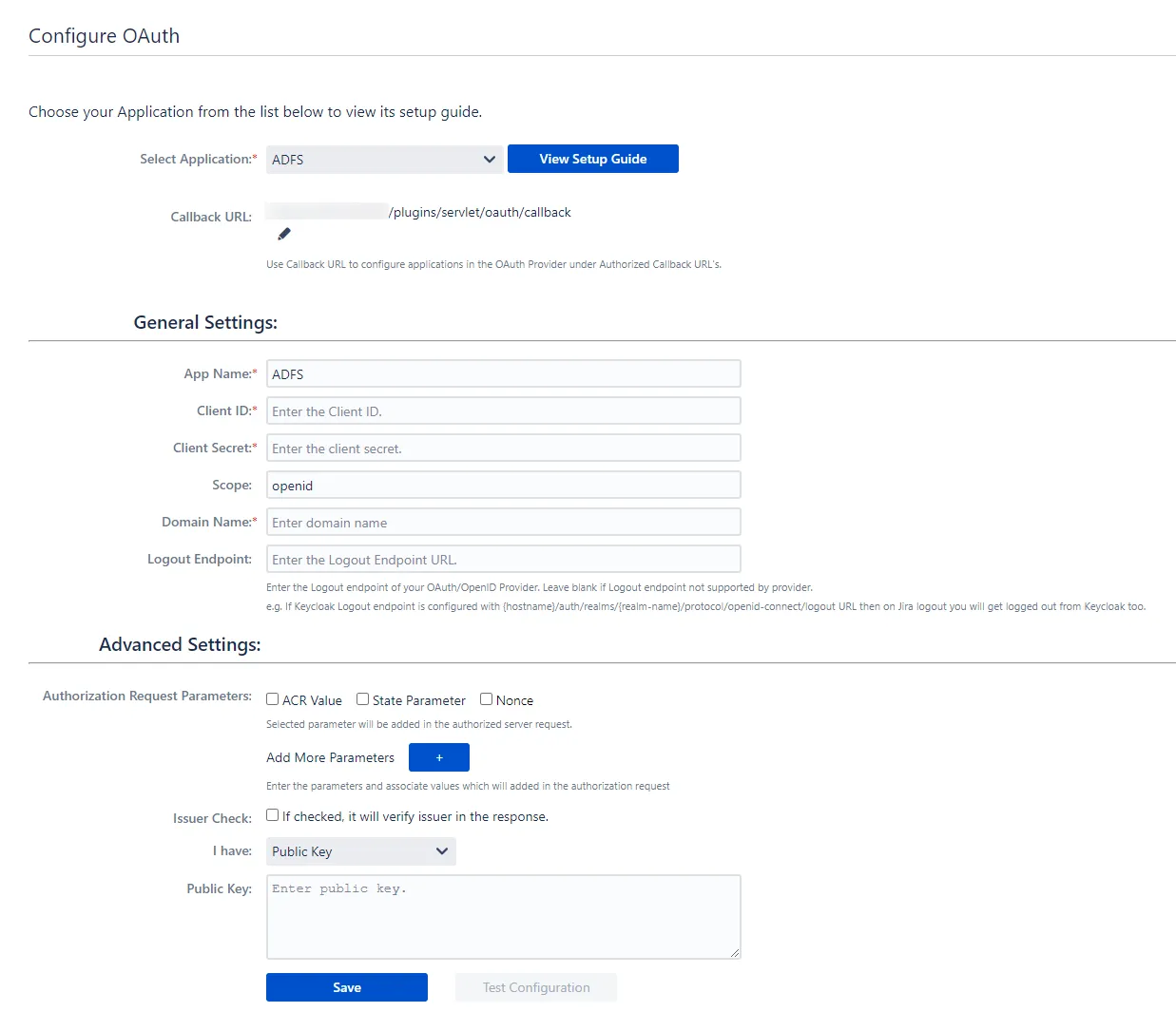
Step 3: User Profile
-
We will be setting up user profile attributes for Jira. If your users are stored in a directory that is Read Only, please check Disable Attribute Mapping in User Profile tab and follow steps given in Matching a User.
- Go to Configure OAuth tab. Scroll down and click on Test Configuration.
- You will see all the values returned by your OAuth/OpenID Provider to Jira in a table. If you don't see a value for First Name, Last Name, Email or Username, make the required settings in your OAuth/OpenID Provider to return this information.
- Once you see all the values in Test Configuration, keep the window open and go to User Profile tab.
- In this tab, fill the values by matching the name of the attribute. For instance, if the Attribute Name in the Test Configuration window is NameID, enter NameID against Username
- Setting up both Username and Email is required if you want to let users register. If you want existing users to the only login, configure the attribute using which you will match the user in Jira.
- Go to User Profile tab
- Select Username or Email for Login/Search Jira user account by
- Enter the attribute name from OAuth/OpenID Provider which corresponds to Username or Email using Finding Correct Attributes
- The custom attributes recieved in the OAuth/OpenID response can be configured using Configure User Properties(Custom Attributes) option.
- Click Add Attributes .
- Enter the attribute name( E.g. department) as User Property Key.
- This option will be added in the profiles of Jira Users.
- Corresponding to this key, fill the attribute value you recieved in Test Configuration window. For instance, if the Attribute Name in the Test Configuration window is Department, enter Department as Attribute.
- Another attribute e.g. location can be added by reclicking on Add Attributes option.
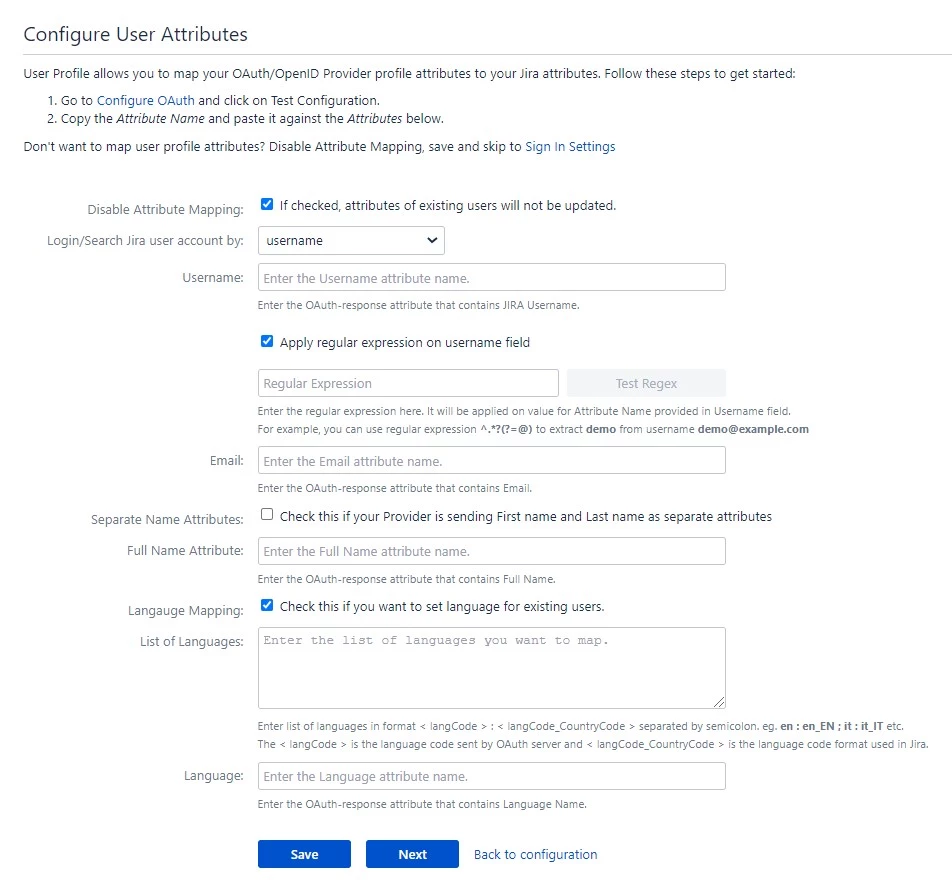
a. Finding correct attributes
b. Setting profile attributes
c. Matching a User
When the user logs into Jira, one of the user's data/attribute coming in from the OAuth/OpenID Provider is used to search the user in Jira. This is used to detect the user in Jira and log in the user to the same account.d. Custom Attribute Mapping

Step 4: User Groups
-
We will be setting up user group attributes for Jira. If your users are stored in a directory that is Read Only, please check Disable Group Mapping in User Groups tab and skip to Setting default group.
- Select the users' Default Group in the tab User Groups. If no group is mapped, users are added by default to this group.
- You can enable default groups for All Users or New Users using the option.Select None if you don't want to assign any default group to SSO users. Using the option Enable Default Groups for.
- Just like we found Attribute Name for User Profile attributes, we find group attribute.
- Go to Configure OAuth tab. Scroll down and click on Test Configuration.
- You will see all the values returned by your OAuth/OpenID Provider to Jira in a table. If you don't see value with groups, make the required settings in your OA uth Providerto return group names.
- Once you see all the values in Test Configuration, keep the window open and go to User Groups tab.
- Enter the Attribute Name of group against Group Attribute.
- Check Disable Group Mapping option if you don't want to update groups of existing users.
- Manual group mapping: If the names of groups in Jira are different than the corresponding groups in OAuth/OpenID Provider, then you should use Manual group mapping.
- On-The-Fly group mapping: If the names of groups in Jira and OAuth/OpenID Provider are same, you should use On-The-Fly group mapping.
a. Setting default group

b. Finding Group Attribute
c. Group Mapping
Group Mapping can be done in two ways:I. Manual Group Mapping
- Check Restrict User Creation Based on Group Mapping option if you want new users to be created only if at least one of the user's OAuth/OpenID Provider groups is mapped to a group in the application.
- For mapping, first select a Jira group from the dropdown which lists all groups present in Jira and then enter the name of the OAuth/OpenID Provider group to be mapped in the textbox beside
- For example, if you want all users in 'dev' group in OAuth/OpenID Provider to be added to jira-software-users, you will need to select jira-software-users from the dropdown and enter 'dev' against jira-software-users.
- Use '+1' and '+10' buttons to add extra mapping fields.
- Use '-' button next to each mapping to delete that mapping.
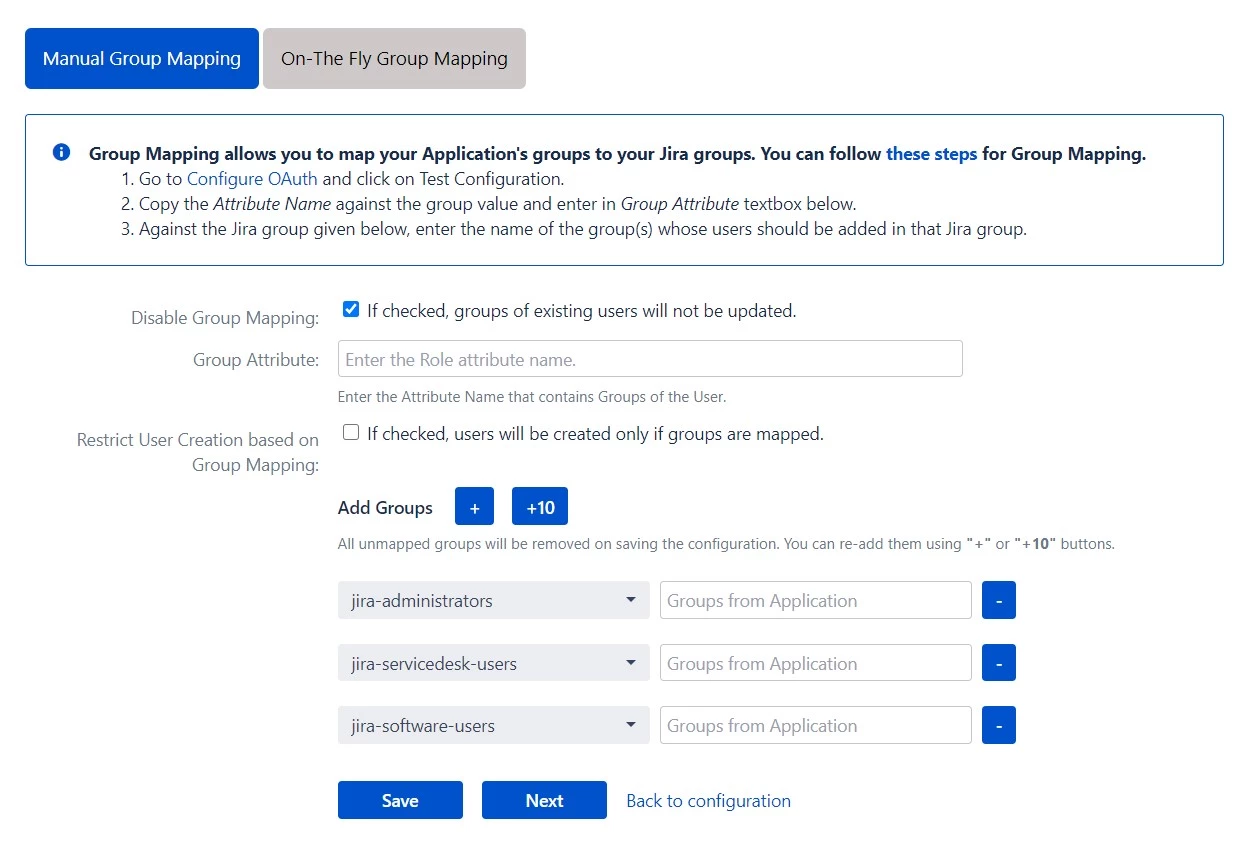
II. On-The Fly Group Mapping
- Check Create New Groups option if you want new groups from OAuth/OpenID Provider to be created if not found in Jira.
- If the user is part of some group in Jira and that group is not present in the OAuth/OpenID response returned by OAuth/OpenID Provider, then the user will be removed from that group in Jira.
- If you don't want On-The-Fly group mapping to affect Jira groups which are managed locally then add those groups in Exclude Groups field.

Step 5: Sign In Settings
-
The settings in the SSO Settings tab define the user experience for Single Sign On.
- Set Enable SSO for Jira Software to allow SSO for Jira Software users.
- Change the text on the SSO button on the login page using the Login Button Text option.
- Set the Relay State to the URL to which the users would be redirected after login. Keep this empty to redirect users to the same page they started with.
- Enable Auto-redirect to OAuth/OpenId Provider if you want to allow users to login only using OAuth/OpenId Provider. Enable backdoor for emergency.
- Restrict the access of backdoor URL to limited users by using the Restrict backdoor URL access based on user groups feature.
- Use Domain Restriction to allow login to only a specific set of users. You can configure multiple domains (semicolon-separated).
- For example, if only 'miniorange.com' and 'gmail.com' domains are allowed then, the user test@miniorange.com and test@gmail.com will be able to log in and user test@yahoo.com will not be able to login.
- Select Secure Admin Login Options to control admin access. User needs to authenticate again to access admin settings or to perform any admin operation. This helps you to add an extra level of security for admin access.
- Set Enable SSO For ServiceDesk Customer Portal to allow SSO for Service Desk user.
- Set Enable SSO Only For Agents to allow SSO only for specific set of users.
- Enable Auto-redirect to Provider if you want to allow users to login to ServiceDesk only using provider and use Disable Auto Redirect to Provider to allow basic login for selective customer portals.
- Set Logout URL or Logout Template to redirect users after logout action.
- Set error template to redirect users to a custom error page instead of login page. Use this if you have Auto-redirect to Provider enabled.
- Set the restriction to access of Plugin API outside the Jira environment by Restrict access to plugin API's.
a. Sign In Settings
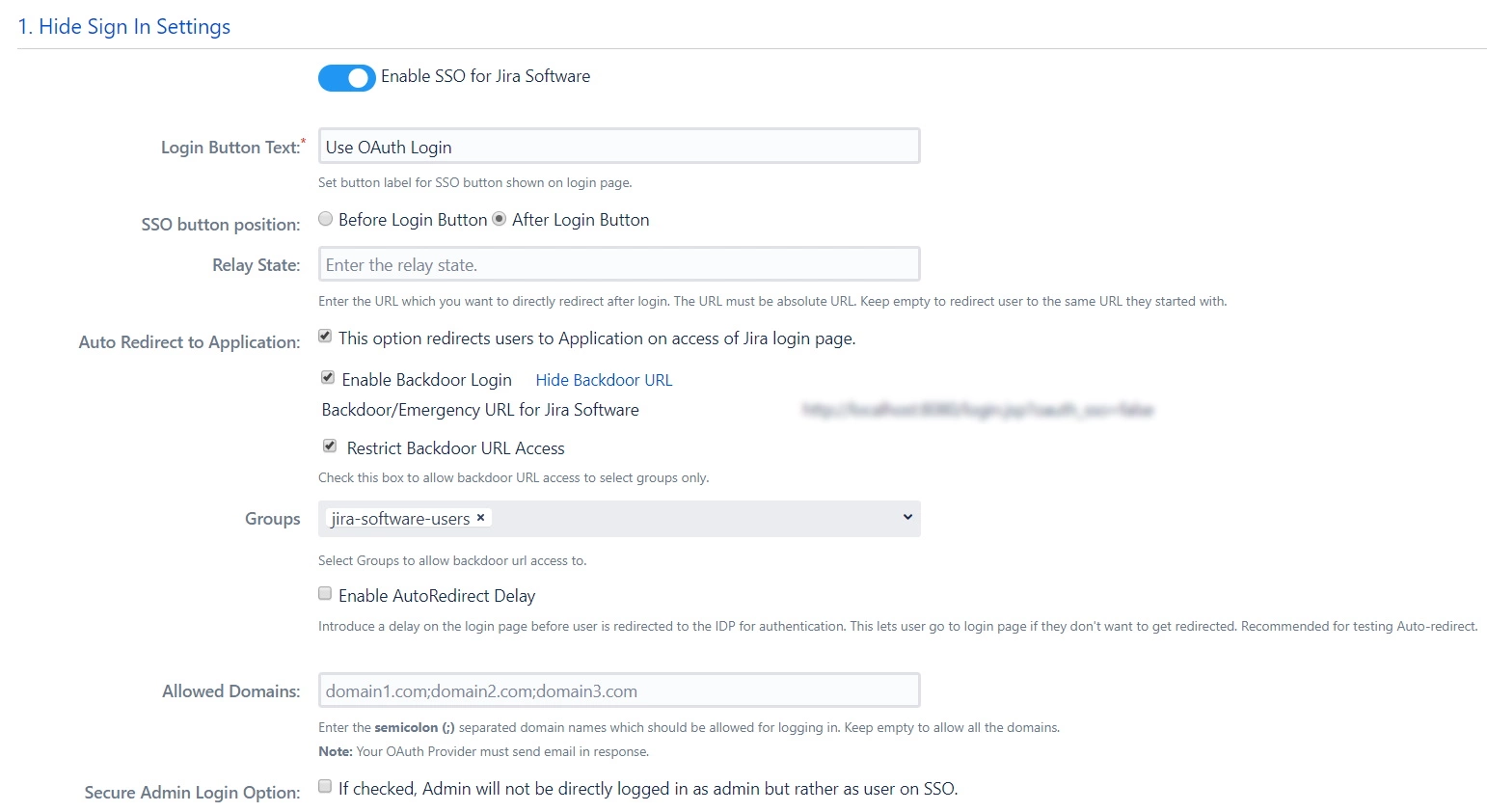
b. Service Desk SSO Settings
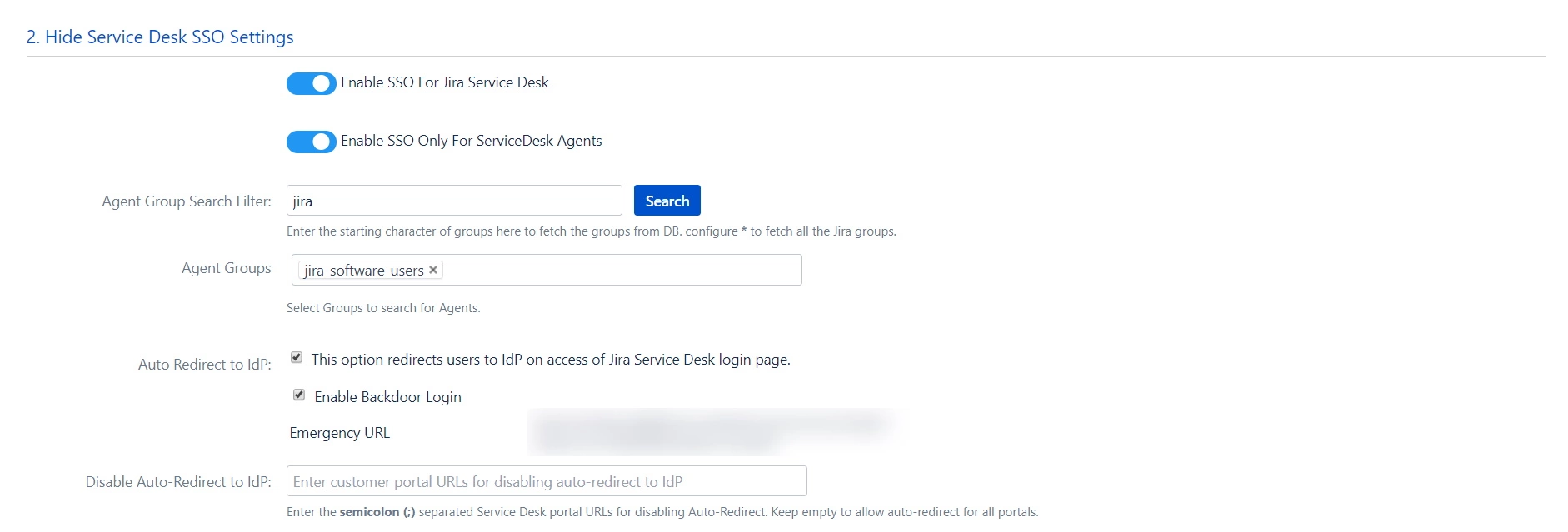
c. Sign Out Settings
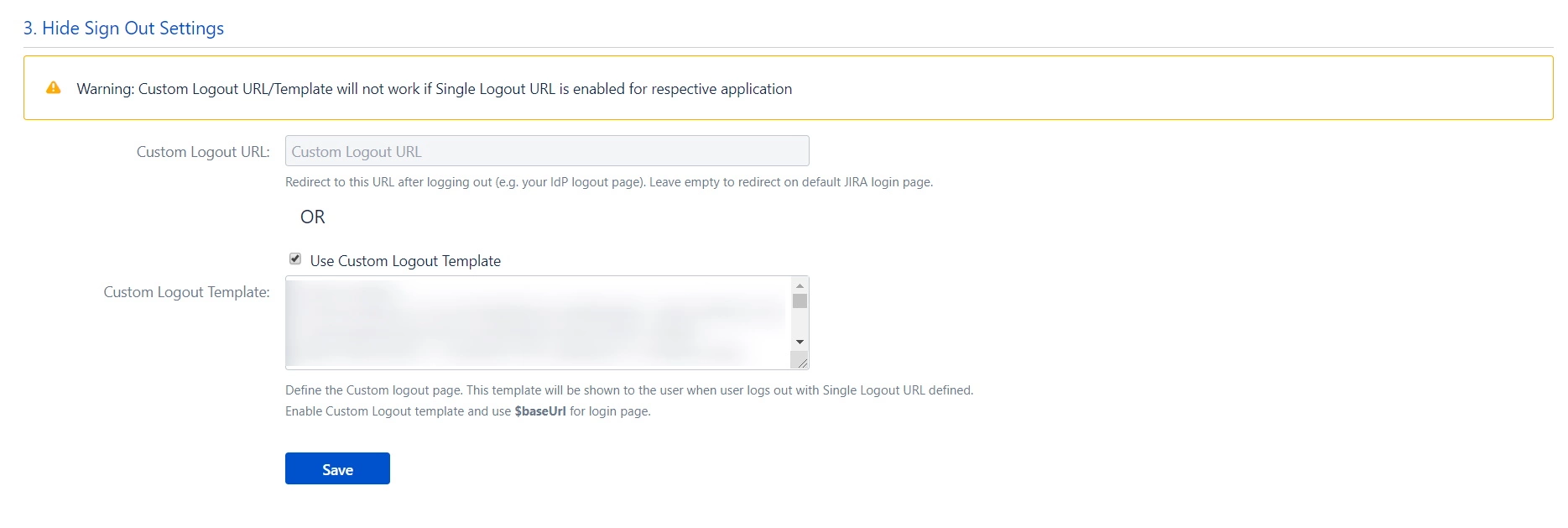
d. SSO Error Settings
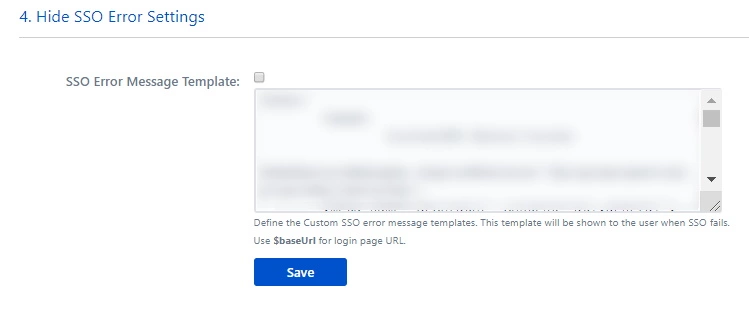
e. Advanced SSO Settings

Additional Resources
- What is OAuth 2.0?
- ADFS as OAuth Provider / OpenID Connect
- Bulk User Management
- Jenkins Single Sign On (SSO)
- SonarQube Single Sign On (SSO)
- Frequently Asked Questions (FAQs)
Our Other Apps:
SAML SSO Apps
|
OAuth Apps
|
2FA Apps
|
Crowd Apps
|
REST API Apps
|
Kerberos/NTLM Apps
|
User Sync Apps
|
Bitbucket Git Authentication App | Jenkins SSO | SonarQube SSO
Bitbucket Git Authentication App | Jenkins SSO | SonarQube SSO
If you are looking for anything which you cannot find, please drop us an email on info@xecurify.com
Trending searches:

